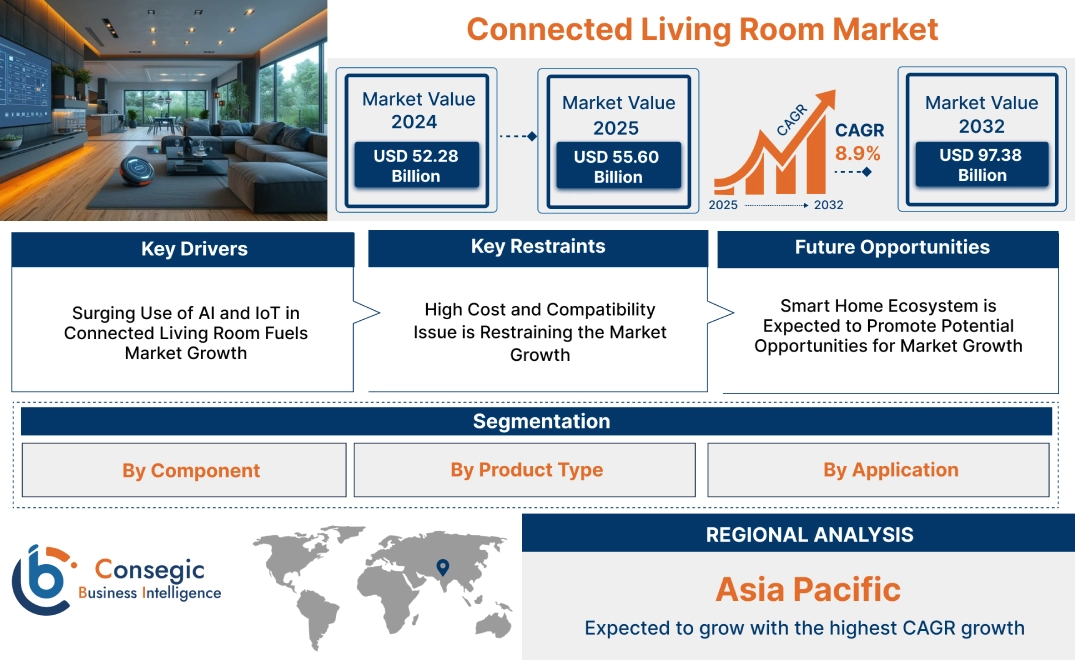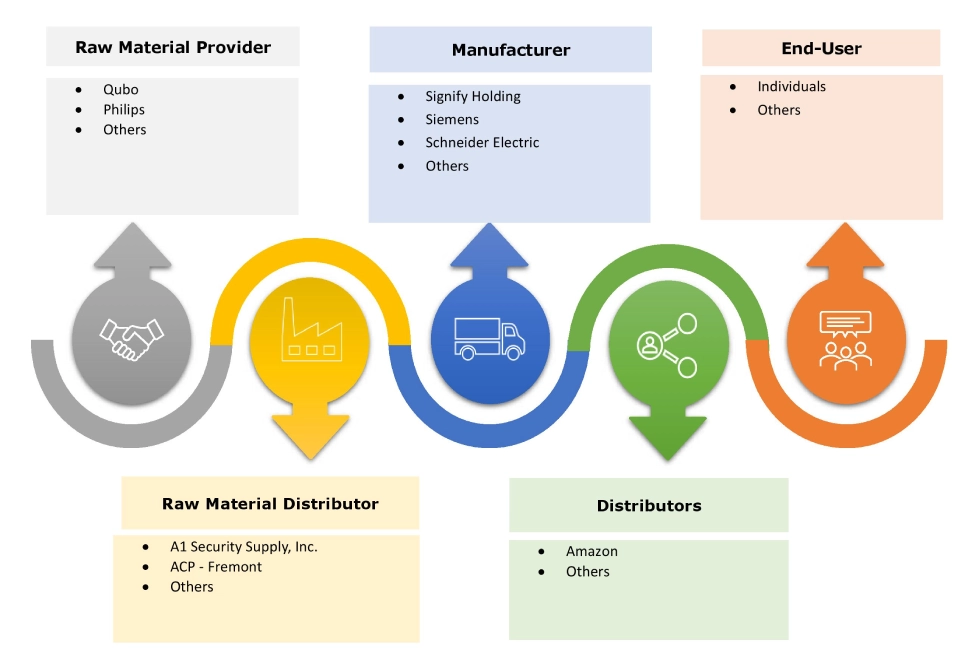Connected Living Room Market Size:
Connected Living Room Market size is estimated to reach over USD 97.38 Billion by 2032 from a value of USD 52.28 Billion in 2024 and is projected to grow by USD 55.60 Billion in 2025, growing at a CAGR of 8.9% from 2025 to 2032.
Connected Living Room Market Scope & Overview:
The connected living room is a home environment in which various devices such as TVs, streaming devices, and smart home appliances among others are integrated together, allowing seamless control and entertainment. Additionally, the advantages include increased convenience and control, energy efficiency, enhanced entertainment, and increased security among others which in turn drives the connected living room market growth. Further, integration of various home appliances for improving the user experience is driving the connected living room market demand.
How is AI Transforming the Connected Living Room Market?
There is a rising adoption of AI in the connected living room market. AI-powered solutions are being used for facilitating more personalized, intuitive, and predictive user experiences for enhancing entertainment, automation, and overall convenience within the home. Moreover, AI-powered voice assistants such as Amazon Alexa and Google Assistant play a vital role in controlling devices, playing media, and managing tasks, making interactions more seamless and convenient.
Additionally, AI also facilitates smart home automation by allowing devices to learn from user behavior and make real-time adjustments to optimize comfort, energy use, and convenience. Consequently, the above factors are expected to propel the market growth during the forecast period.
Connected Living Room Market Dynamics - (DRO) :
Key Drivers:
Surging Use of AI and IoT in Connected Living Room Fuels Market Growth
The rapidly growing consumer electronics sector is driving the adoption of emerging technologies such as AI and IoT technology to enable automation, enhanced security, and increased convenience among others is driving the connected living room market growth. Additionally, IoT devices such as smart indoor lights, thermostats, speakers, and others enable seamless communication and data sharing when connected to internet in turn allowing control and monitoring of homes remotely in turn driving the connected living room market demand.
- For instance, in February 2021, Panasonic launched Miraie which is an extended the IoT & AI enabled connected living platform including refrigerator, washing machine, fan, switches and others on the platform.
Therefore, the integration of AI and IoT with consumer appliances, in turn proliferating the growth of the market.
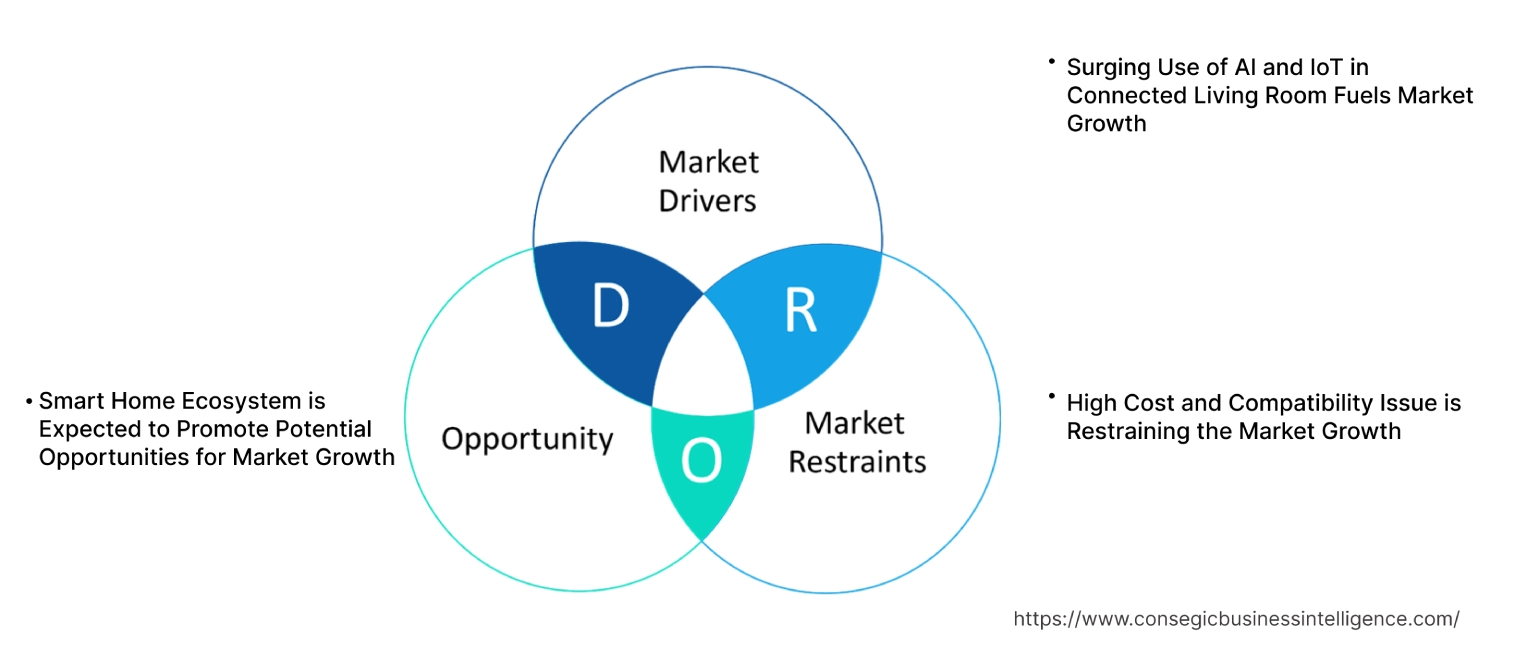
Key Restraints:
High Cost and Compatibility Issue is Restraining the Market Growth
The smart home devices such as smart TVs and sound systems among others are expensive in turn hindering the adoption in budget constrain end users. Additionally, different models and brands of smart devices cause compatibility issues in turn hindering the connected living room market expansion. Therefore, the high costs and compatibility issues in smart home devices is restraining the connected living room market expansion.
Future Opportunities :
Smart Home Ecosystem is Expected to Promote Potential Opportunities for Market Growth
The smart home ecosystem integrates internet-connected devices and appliances for remote control which in turn improves convenience, security, and comfort as well as reducing energy consumption in turn fueling the connected living room market opportunities. Additionally, the smart home ecosystem when connected via network, allows homeowners to adjust settings and monitor their home remotely in turn driving the connected living room industry.
- For instance, in March 2025, Dreame Technology launched smart-home ecosystem in an immersive 800 sqm exhibition space include intelligent cleaning devices, smart kitchen solutions, and others.
Hence, the improvements in convenience, security as well as reducing energy consumption is anticipated to increase the utilization, in turn promoting connected living room market opportunities during the forecast period.
Connected Living Room Market Segmental Analysis :
By Component:
Based on the component, the market is segmented into sensors, thermostats, cameras, communication device, and others.
Trends in the Component:
- The increasing focus towards optimizing energy consumption and comfort is driving the adoption of thermostats which in turn drives the connected living room market trend.
- The communication devices such as smartphone, tablet and others are utilized for facilitating seamless and interactive living space, driving the connected living room market trend.
Cameras accounted for the largest revenue share in the year 2024 and is anticipated to register the fastest CAGR during the forecast period.
- Cameras play a vital role in enhancing security and convenience as well as interact with family members or visitors through video calls.
- Further, the camera is utilized to monitor activities, record video, alert in unusual situations and others, driving the adoption of cameras which in turn fuels connected living room market share.
- For instance, in June 2022, Samsung Electronics launched SmartThings Home Life which offers services such as SmartThings cooking, energy, clothing care, pet care, and others. The services integrate smart cameras and other devices with SmartThings Home Life to offer remote access and control over the rooms.
- Thus, according to the connected living room market analysis, the enhanced security and convenience is driving the connected living room market share.
By Product Type:
Based on the product type, the market is segmented into smart TVs,gaming consoles, computer and laptop, smart speakers, smartphones and tablets, security system, and lighting system.
Trends in the Product Type:
- The trend towards rise in gaming culture is propelling the demand for immersive gaming setup which in turn is driving the adoption of gaming consoles.
- The trend towards layering different types of lights and connecting them with communication devices for creating immersive living room experience is driving the adoption of lighting system.
Smart TVs accounted for the largest revenue share in the year 2024.
- The smart TV integrated easily with other smart devices as well as create central hub for entertainment. The integration offers seamless browsing, gaming, entertainment and others.
- Further, the integration of home lighting system with the smart TV for creating an immersive and realistic experience is driving the adoption of smart TVs which in turn boost the connected living room market size.
- For instance, in March 2024, Samsung SmartThings extended the partnership with Philips Hue to revolutionize home entertainment systems. The partnership offers TV-centered smart home which is controlled through Philips Hue Sync TV App which elevates user experience.
- Thus, according to the connected living room market analysis, the ability to provide immersive and realistic experience drives the connected living room market size.
Smartphones and Tablets is anticipated to register the fastest CAGR during the forecast period.
- Smartphones and tablets act as a communication device which allows users to manage smart connected devices.
- Additionally, the rising adoption of Wi-Fi and Bluetooth technology for seamless communication between smart devices and smartphones and tablets is driving the market progress.
- Also, smartphones and tablets are widely utilized to connect lights, thermostats, security cameras, and smart locks among others to provide convenient access and management is driving the market development.
- Further, the ability to manage various devices and appliances remotely via mobile apps is driving the adoption of smartphones and tablets.
- Therefore, as per the market analysis, the ability to seamlessly communicate between devices as well as offering convenient access and management are anticipated to boost the market during the forecast period.
By Application:
Based on the application, the market is segmented into video streaming, audio streaming, and gaming.
Trends in the Application:
- The trend towards rise of live streaming music and increasing demand for high quality audio is driving the market adoption in audio streaming applications.
- The trend towards expansion of cloud gaming services is paving the way for market adoption in gaming applications.
Video Streaming accounted for the largest revenue share of 42.01% in the year 2024.
- The connected living room offers centralized control, enhanced convenience as well as easy access to a wider range of streaming services is driving the video streaming application.
- Additionally, the integration of AR and VR glasses for video streaming is driving the market progress.
- Further, the surge in OTT viewership as well as 5G advancements is driving the adoption of connected living room for video streaming applications.
- For instance, in March 2024, Nokia revealed that 5G users are using approximately 3.6 times as much mobile data traffic compared to 4G in 2022 as well as 5G contributing to 15 percent of all data traffic in 2023 in India.
- Thus, as per the market analysis, surge in OTT viewership as well as 5G advancements is driving the video streaming application in connected living room market.
Audio Streaming is anticipated to register the fastest CAGR during the forecast period.
- The rising adoption of multi-room audio systems which seamlessly integrate with smart living system to offer personalized ambiance which in turn enhances entertainment.
- Additionally, the advantages include enhanced entertainment, easy integration with smart home systems, improved aesthetics and reduced clutter among others is driving the adoption of market in audio streaming applications.
- Further, the increasing popularity of smart speakers with voice assistants such as Alexa, google assistant, and others is driving the market adoption in audio streaming applications.
- Therefore, as per the market analysis, the increasing popularity of smart speakers with voice assistants is anticipated to boost the market during the forecast period.

Regional Analysis:
The regions covered are North America, Europe, Asia Pacific, the Middle East and Africa, and Latin America.
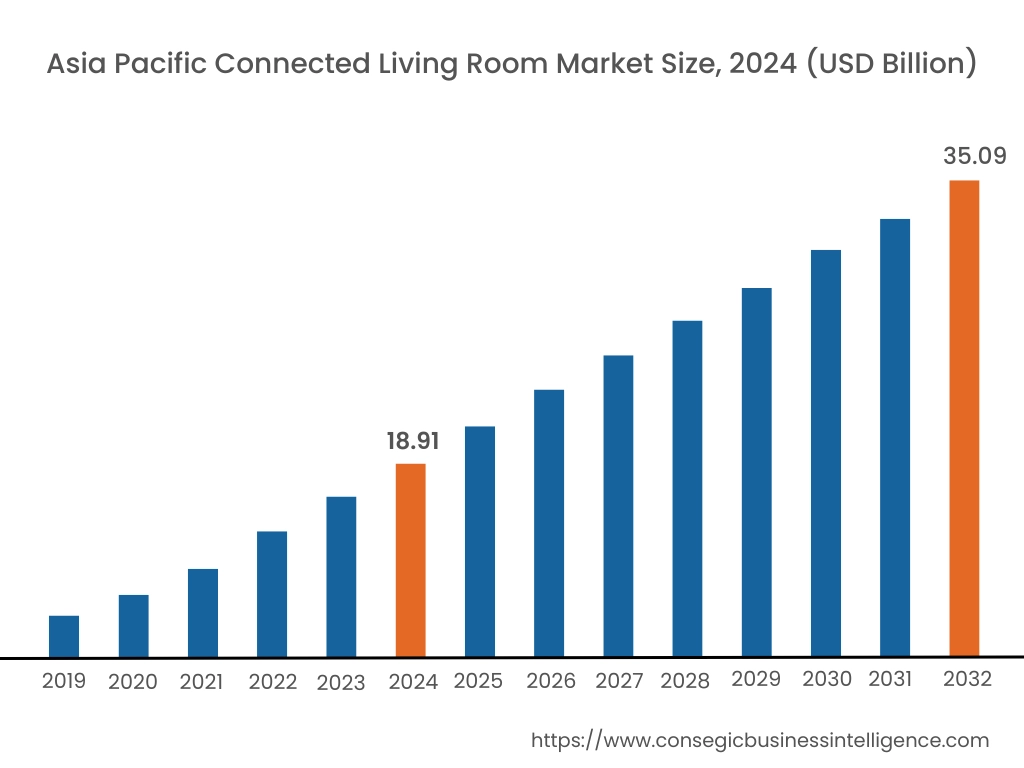
Asia Pacific region was valued at USD 18.91 Billion in 2024. Moreover, it is projected to grow by USD 20.10 Billion in 2025 and reach over USD 35.09 Billion by 2032. Out of this, China accounted for the maximum revenue share of 34.61%. The market is mainly driven by growing consumer electronics industry. Furthermore, factors including rising streaming services as well as rising 5G adoption in India are projected to drive the market progress in Asia Pacific region during the forecast period.
- For instance, according to IBEF, Electronics hardware production in India stood at USD 87 billion in 2022 as well as India exports for white goods such as Refrigerators, Air Conditioners and others reached USD 571 Million in 2021 in turn paving the way for market development.
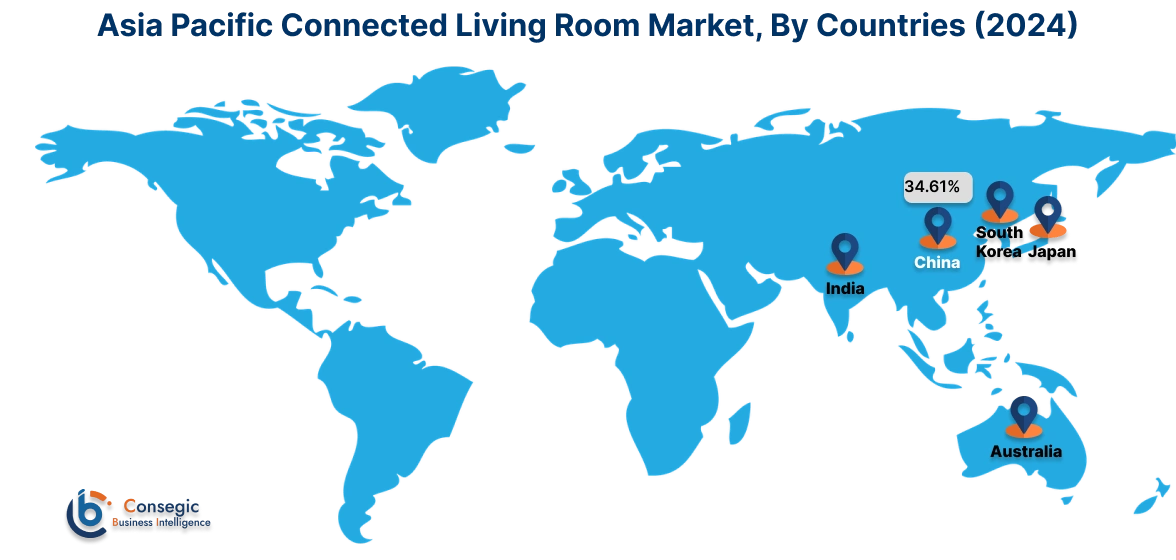
North America is estimated to reach over USD 27.69 Billion by 2032 from a value of USD 14.45 Billion in 2024 and is projected to grow by USD 15.40 Billion in 2025. The North American region's robust internet penetration rate offers lucrative growth prospects for the market. Additionally, the growing adoption of smart home devices and rising popularity of streaming services is driving the market progress.
- For instance, in October 2024, Ashley partnered with Samsung Electronics for integrating Samsung SmartThings with Ashley stylish furnishings to elevate the lifestyle of consumer.
The regional analysis depicts that the increasing investing in smart city initiatives is driving the market in Europe. Additionally, the key factor driving the market is rise in smart home integration and demand for advanced entertainment and home automation systems in the Middle East and African region. Further, the growing demand for entertainment and personalized services is paving the way for the progress of market in Latin America region.
Top Key Players and Market Share Insights:
The global connected living room market is highly competitive with major players providing connected living room to the national and international markets. Key players are adopting several strategies in research and development (R&D), product innovation, and end-user launches to hold a strong position in the connected living room industry. Key players in the connected living room market include-
- LG Electronics (South Korea)
- Legrand SA (France)
- Honeywell International Inc. (USA)
- Google LLC (USA)
- ASSA ABLOY (Sweden)
- Sony Corporation (Japan)
- Signify Holding (Netherlands)
- Siemens (Germany)
- Schneider Electric (France)
- SAMSUNG (South Korea)
Recent Industry Developments :
Product Launch:
- In August 2024, LG Electronics launched ThinQ ON AI home hub for seamlessly connecting vast array of appliances and IoT devices. The hub provides tailored user experience accelerating the adoption of market.
Collaborations and Partnerships:
- In February 2025, Arlo Technologies, Inc. partnered with Samsung SmartThings to enable easy control and convenience in managing smart home security as well as offer seamless user experience.
Connected Living Room Market Report Insights :
| Report Attributes | Report Details |
| Study Timeline | 2019-2032 |
| Market Size in 2032 | USD 97.38 Billion |
| CAGR (2025-2032) | 8.9% |
| By Component |
|
| By Product Type |
|
| By Application |
|
| By Region |
|
| Key Players |
|
| North America | U.S. Canada Mexico |
| Europe | U.K. Germany France Spain Italy Russia Benelux Rest of Europe |
| APAC | China South Korea Japan India Australia ASEAN Rest of Asia-Pacific |
| Middle East and Africa | GCC Turkey South Africa Rest of MEA |
| LATAM | Brazil Argentina Chile Rest of LATAM |
| Report Coverage |
|
Key Questions Answered in the Report
How big is the connected living room market? +
The connected living room market size is estimated to reach over USD 97.38 billion by 2032 from a value of USD 52.28 billion in 2024 and is projected to grow by USD 55.60 billion in 2025, growing at a CAGR of 8.9% from 2025 to 2032.
What specific segmentation details are covered in the connected living room report? +
The connected living room report includes specific segmentation details for component, product type, application, and regions.
Which is the fastest segment anticipated to impact the market growth? +
In the connected living room market, the audio streaming is the fastest-growing segment during the forecast period due to increasing popularity of smart speakers with voice assistants.
Who are the major players in the connected living room market? +
The key participants in the connected living room market are LG Electronics (South Korea), Legrand SA (France), Honeywell International Inc. (USA), Google LLC (USA), ASSA ABLOY (Sweden), Sony Corporation (Japan), Signify Holding (Netherlands), Siemens (Germany), Schneider Electric (France), SAMSUNG(South Korea) and others.
What are the key trends in the connected living room market? +
The connected living room market is being shaped by several key trends including trend towards increasing focus towards optimizing energy consumption and comfort as well as expansion of cloud gaming services and other are the key trends driving the market.
